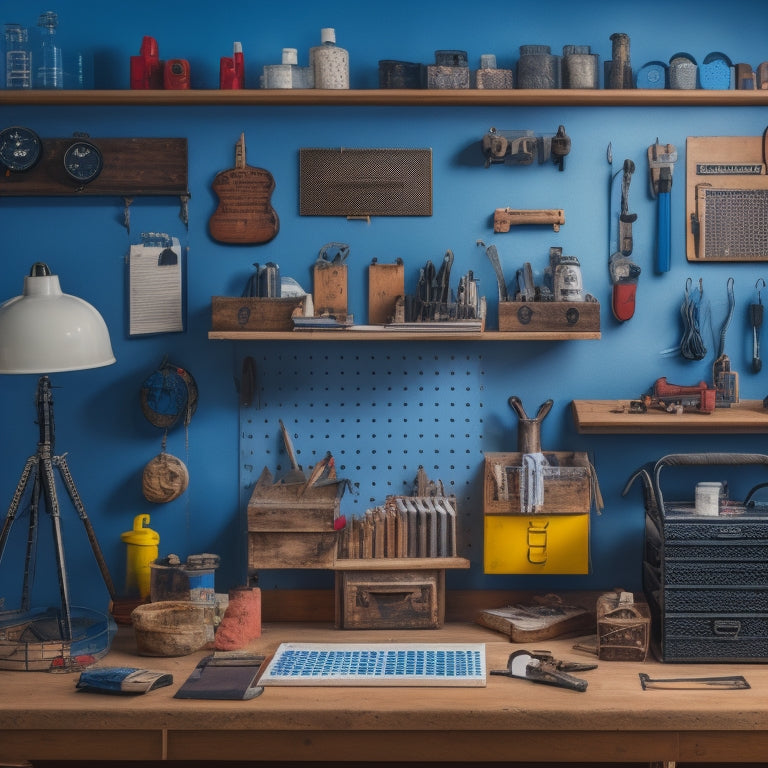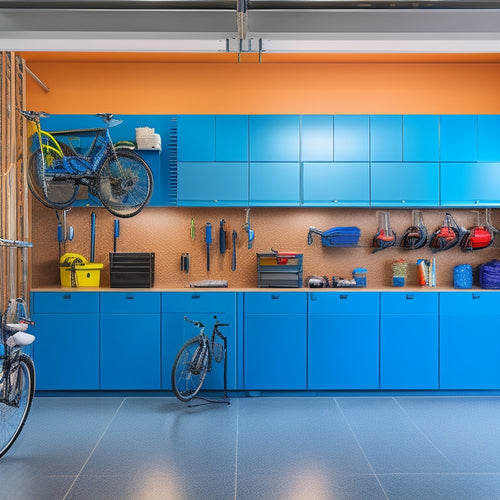
Maximize Your DIY Time With These Productivity Hacks
Share
You're ready to maximize your DIY time! Start by creating a task list with clear objectives and critical tasks. Designate a distraction-free workspace zone with easy access to tools and materials. Set realistic project timelines by estimating task duration accurately, and break down tasks into achievable blocks. Eliminate distractions immediately by setting boundaries with family and friends, and utilize a centralized tool station for efficiency. Master the art of batch work, implement the 'One-Touch' Rule, and stay organized with labels. Limit social media access to boost focus. By implementing these habits, you'll be well on your way to DIY productivity - and that's just the beginning of your journey to getting more done in less time!
Key Takeaways
• Create a task list with clear objectives and critical tasks to stay focused on your DIY project's goals.
• Designate a distraction-free workspace zone with easy access to tools and materials to boost efficiency.
• Set realistic project timelines by estimating task duration accurately to avoid procrastination and burnout.
• Implement the 'One-Touch' Rule to complete tasks in one session, reducing stress and increasing workflow efficiency.
• Schedule social media breaks and use apps to block access during work hours to minimize distractions and stay on track.
Prioritize Tasks With a List
Create a task list the night before or first thing in the morning to clarify your DIY project's objectives and identify the most critical tasks that need your attention. This simple habit will help you prioritize your tasks and make the most of your time.
Break down your project into smaller, manageable tasks using Task Segmentation. This will make it easier to focus on one task at a time, reducing overwhelm and increasing productivity.
Organize your tasks using a List Hierarchy, categorizing them into must-haves, should-haves, and nice-to-haves. This will help you allocate your time and energy on the most critical tasks first. You'll be surprised at how quickly you can tackle the essential tasks, giving you a sense of accomplishment and momentum.
Designate a Workspace Zone
With your tasks prioritized and organized, now allocate a specific area for your DIY project, designating a workspace zone that's free from distractions and interruptions. This zone will be your sanctuary, where you can focus on your project without worrying about clutter or interruptions.
When setting up your workspace layout, consider the tools and materials you'll need. Place them within easy reach to minimize walking distances and maximize your productivity. Establish clear zone boundaries to keep family members or roommates from accidentally interrupting your workflow. You can use dividers, curtains, or even a makeshift wall to create a physical barrier.
A well-designed workspace zone will help you stay focused and motivated. It'll also help you avoid procrastination and reduce stress.
Set Realistic Project Timelines
When planning a DIY project, it's crucial to set realistic timelines to avoid frustration and burnout.
You can do this by estimating the duration of each task and breaking down large projects into manageable chunks.
Estimate Task Duration
Accurately predicting how long each task will take is essential to setting realistic project timelines, so take a moment to reflect on how you've spent your time on similar tasks in the past. This Task Benchmarking exercise will help you identify patterns and average duration for specific tasks.
For instance, if you've found that painting a room typically takes you three hours, you can use that as a benchmark for future projects.
Next, apply Timeboxing Strategies to allocate specific time slots for each task. This will help you stay focused and avoid under or overestimating the time required. Be realistic about your work pace and consider factors like breaks and potential setbacks.
By assigning a realistic duration to each task, you'll be able to create a project timeline that's achievable and stress-free. Remember, the goal is to set yourself up for success, not to set unrealistic expectations.
With accurate task duration estimates, you'll be able to make the most of your DIY time and enjoy a sense of accomplishment as you complete each project.
Break Down Large Tasks
You'll find that large tasks can be overwhelming, but breaking them down into smaller, manageable chunks allows you to create realistic project timelines and make steady progress.
This process is called Task Segmentation, and it's a powerful tool for achieving your DIY goals.
By breaking down large tasks into smaller micro-goals, you'll be able to:
- Focus on a single task at a time, reducing feelings of overwhelm and anxiety
- Make consistent progress, which can be incredibly motivating
- Identify potential roadblocks and pitfalls early on, allowing you to adjust your plan accordingly
- Celebrate small victories along the way, which can help keep you energized and engaged
Eliminate Distractions Immediately
By setting clear boundaries with family and friends, you can minimize interruptions and create a distraction-free zone that allows you to focus on your DIY project. Establishing phone etiquette is key to achieving this. Designate specific times for checking and responding to messages, and let your loved ones know when you're available for calls or texts. This way, you can avoid the constant ping of notifications and stay on track.
Boundary setting is also essential in maintaining your productivity. Communicate your work hours and needs to your household members, and ask them to respect your DIY time. If possible, set up a dedicated workspace that's off-limits to others during your work hours. This will help you avoid distractions and stay committed to your project.
Use a Centralized Tool Station
Set up a centralized tool station to keep all your DIY project necessities within arm's reach, saving you time and energy that would be wasted on constant searching and retrieving. This will become your go-to hub for all your DIY projects, making it easy to access the tools you need when you need them.
Here are some key considerations to keep in mind when designing your station:
-
Tool Cart: Invest in a sturdy tool cart with multiple drawers and shelves to store your tools and supplies. This will help keep everything organized and within reach.
-
Station Design: Design your station to fit your specific needs. Consider the types of projects you'll be working on and the tools you'll need for each one.
-
Ergonomic Layout: Set up your station to minimize bending and stretching. This will help reduce fatigue and make your DIY experience more enjoyable.
- Cable Management: Keep cords and cables organized using cable ties or a cord organizer. This will prevent tangles and make it easier to find what you need.
Schedule Breaks for Recharging
When you're in the midst of a DIY project, it's easy to get caught up in the momentum and forget to take a step back. But, you'll actually get more done in the long run if you schedule regular breaks to recharge.
Take Regular Timeouts
You'll be more focused and productive if you take regular timeouts to recharge, which is why scheduling breaks into your DIY project timeline is essential. By incorporating mindful moments into your schedule, you'll avoid burnout and maintain your energy levels throughout the project.
Here are some self-care strategies to incorporate:
-
Take a 10-minute walk outside to refresh your mind and get some fresh air
-
Practice deep breathing exercises to calm your mind and reduce stress
-
Grab a healthy snack or meal to refuel and recharge
- Engage in a quick stretch or yoga routine to loosen up tight muscles and improve circulation
Reboot and Refresh
Prioritizing reboot and refresh breaks is crucial for restoring your mental and physical energy, ensuring a consistent flow of creativity and productivity throughout your DIY project. Scheduling breaks is vital to avoid burnout and maintain your momentum.
Start your week with a Mindful Monday, where you take a few minutes to set intentions and reflect on your goals. This sets the tone for a focused and productive week.
Throughout the week, take short breaks every hour to stretch, move around, and refresh your mind. This Creative Detox will help you clear your thoughts and come back to your project with renewed energy.
Consider implementing a 'Pomodoro Timer' technique, where you work in focused 25-minute increments, followed by a 5-minute break. This technique will help you stay on track and avoid exhaustion.
Master the Art of Batch Work
Take control of your DIY projects by grouping similar tasks together, a technique known as batch work, which can greatly boost your productivity and efficiency.
By adopting a batch mentality, you'll streamline your workflow optimization and get more done in less time. This approach allows you to focus on a single task without constant switching, reducing mental fatigue and increasing your overall output.
Here are some ways to apply batch work to your DIY projects:
-
Group similar tasks: Identify tasks that require similar tools, materials, or skills, and tackle them in one session.
-
Schedule batch days: Set aside dedicated days or afternoons for specific tasks, like sanding or painting.
-
Prepare your workspace: Organize your tools and materials beforehand to minimize downtime and maximize productivity.
- Take breaks between batches: Use breaks to recharge and refocus, allowing you to maintain your energy and motivation throughout the project.
Implement a "One-Touch" Rule
As you work on your DIY project, adopt the 'one-touch' rule to eliminate unnecessary repetition and maximize your productivity. This rule is simple: whenever you touch a task, complete it in one go. Don't put it down, only to pick it up again later. By doing so, you'll avoid Decision Fatigue, which can drain your mental energy and slow you down.
When you apply the 'one-touch' rule, you'll notice a significant boost in your Workflow Efficiency. You'll spend less time switching between tasks, and more time making progress on your project. This rule also helps you stay focused, as you'll be fully invested in completing each task before moving on to the next one.
Implementing the 'one-touch' rule requires discipline, but the payoff is worth it. By streamlining your workflow, you'll save time, reduce stress, and enjoy a greater sense of accomplishment.
Stay Organized With Labels
You'll save hours of frustration and searching time by labeling your tools, materials, and components, making sure everything has its designated place and is easily accessible when you need it. This simple habit will help you stay focused on your DIY project, rather than wasting time searching for misplaced items.
To take your labeling game to the next level, consider these tips:
-
Use label color coding to categorize your tools and materials by type or project, making it easy to identify what you need at a glance.
-
Designate a specific label placement on each item, such as the top or side, to maintain consistency and make labels easy to read.
-
Label your storage containers so you can quickly identify what's inside without having to dig through them.
- Create a label template to make sure your labels are uniform and easy to read, and to save time when labeling multiple items.
Limit Social Media Access
Your DIY project timeline is likely to suffer if social media notifications constantly distract you, so set a specific 'social media-free' window to maintain focus. You'll be amazed at how much more you can accomplish when you're not scrolling through your feeds every few minutes.
Take a social detox and set digital boundaries for yourself. Turn off notifications, log out of your accounts, or use an app that blocks social media during your DIY time.
You can also schedule social media breaks throughout the day to give yourself time to recharge and refocus.
Frequently Asked Questions
How Do I Handle Unexpected Tasks That Derail My DIY Project Timeline?
When unexpected tasks pop up, don't panic! You prioritize, focusing on high-impact tasks first. Then, create a contingency plan to tackle the surprise task, ensuring it doesn't derail your entire DIY project timeline.
Can I Really Eliminate All Distractions, or Are Some Necessary?
Can you really eliminate all distractions? Hang on, let's get real - some distractions are necessary, like breaks to recharge. Implement Focus Filters to prioritize, and embrace Productive Procrastination to tackle tasks that fuel your creativity, so you can refocus with renewed energy.
What Tools Are Essential for a Centralized Tool Station?
You're creating a centralized tool station, and you're wondering what tools are essential. Start by prioritizing your most-used tools, then design a station layout that allows easy access and efficient tool organization, making your workflow smoother.
How Often Should I Schedule Breaks to Avoid Burnout?
You know your limits, so schedule breaks every 60-90 minutes to recharge. Take 10-15 minutes to stretch, move around, and refocus - it'll boost your energy levels and provide mental refreshment, keeping you motivated and productive!
Are There Any Exceptions to the 'One-Touch' Rule for DIY Projects?
When tackling DIY projects, you'll often encounter exceptions to the one-touch rule, especially with complex tasks or large project scopes.
Related Posts
-

Heavy-Duty Pegboard Hooks for Industrial Use
You need heavy-duty pegboard hooks that can withstand the rigors of industrial use, providing a reliable and efficien...
-

Top Garage Storage Bins for Organization and Style
You can enhance your garage's style and organization with the right storage bins. Top brands like Rubbermaid, Suncast...
-

What Are the Advantages of a Wooden Tool Box
You choose a wooden tool box, you're not only getting a reliable storage solution, but also a long list of benefits t...


